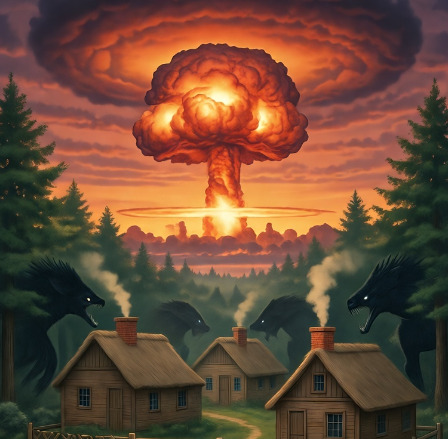
Are Nuclear Bombs Real, or Just the Ultimate Scare Tactic?
In M. Night Shyamalan’s 2004 film The Village, a secluded community thrives under the shadow of terror. Elders spin tales of bloodthirsty creatures lurking beyond the woods, enforcing strict isolation and obedience. The “monsters” are fabrications—costumes and red cloaks—to preserve a utopian bubble free from modern corruption. It’s a chilling allegory for how fear can be engineered to control the masses. What if nuclear bombs operate on the same principle? What if the apocalyptic specter of atomic Armageddon is less a technological reality and more a psychological weapon, designed to instill dread, foster dependency on governments, and pit nations against each other in an endless cycle of suspicion?
Consider the Cold War era, when the U.S. and Soviet Union amassed arsenals capable of ending civilization multiple times over. Schoolchildren ducked under desks, families built backyard bunkers, and politicians invoked “mutually assured destruction” (MAD) as deterrence. But deterrence from what? Sure, we have big bombs—conventional explosives that could level cities, like the 15-megaton Tsar Bomba tested by the Soviets in 1961, which shattered windows 500 miles away. And yes, Hiroshima and Nagasaki in 1945 demonstrated the horrific power of fission: over 200,000 lives vaporized in fireballs hotter than the sun’s core. These events are etched in history, undeniable proof that nuclear weapons exist and kill.
Yet, peel back the layers, and the narrative frays. Has a nuclear bomb ever been used in war since 1945? No. In seven decades of geopolitical brinkmanship—Korea, Vietnam, Cuba, Afghanistan—the button has never been pressed. Why? Proponents of the “hoax” theory argue it’s because the bombs aren’t the doomsday devices sold to us. Delivery systems like ICBMs are real, warheads pack a punch, but the chain reaction of global holocaust? Perhaps exaggerated for effect. Leaked documents and whistleblowers, from Edward Snowden to disgruntled physicists, hint at overblown yields and unreliable tech. The real explosion, they say, is in our minds: fear that governments hold the power of life and death, dangling extinction to justify surveillance states, military budgets, and unquestioned loyalty.
This echoes George Orwell’s 1984, where the Party wages perpetual war not for territory or resources, but to sustain fear. “War is peace,” the slogan goes, as endless conflicts keep the proles distracted, impoverished, and devoted to Big Brother. Nuclear threats serve a similar script. Imagine: Russia invades Ukraine, and suddenly, NATO rattles sabers about tactical nukes. Iran enriches uranium? Cue headlines of “imminent Armageddon.” The cycle breeds xenophobia—us versus them—driving populations into the arms of their protectors. Governments balloon: trillions funneled to “defense” contractors, civil liberties eroded under “national security.” We trade freedom for the illusion of safety, dependent on the very entities stoking the panic.
But is nuclear holocaust something we need to fear? If it’s real, as evidence suggests—thermonuclear fusion tested repeatedly, radiation scars lingering in the Marshall Islands—who cares? The user’s quip rings true: “We shouldn’t live too long if it is.” A full exchange would end us swiftly, no drawn-out dystopia. Better to live boldly than cower in bunkers, rationing canned beans while empires crumble. If it’s a myth, like The Village’s beasts, then the true monster is compliance. We’ve let fear dictate policy, from arms races to isolationism, while climate change—the real extinction event—festers unchecked.
Ultimately, reality bends to perception. Nuclear bombs are real enough to scar the earth, but their greatest yield is terror: a dividend of division and control. Dismantle the myth, question the narrative, and perhaps we’ll step beyond the woods—not as frightened villagers, but as free thinkers. The elders can’t scare us if we refuse to hide.
